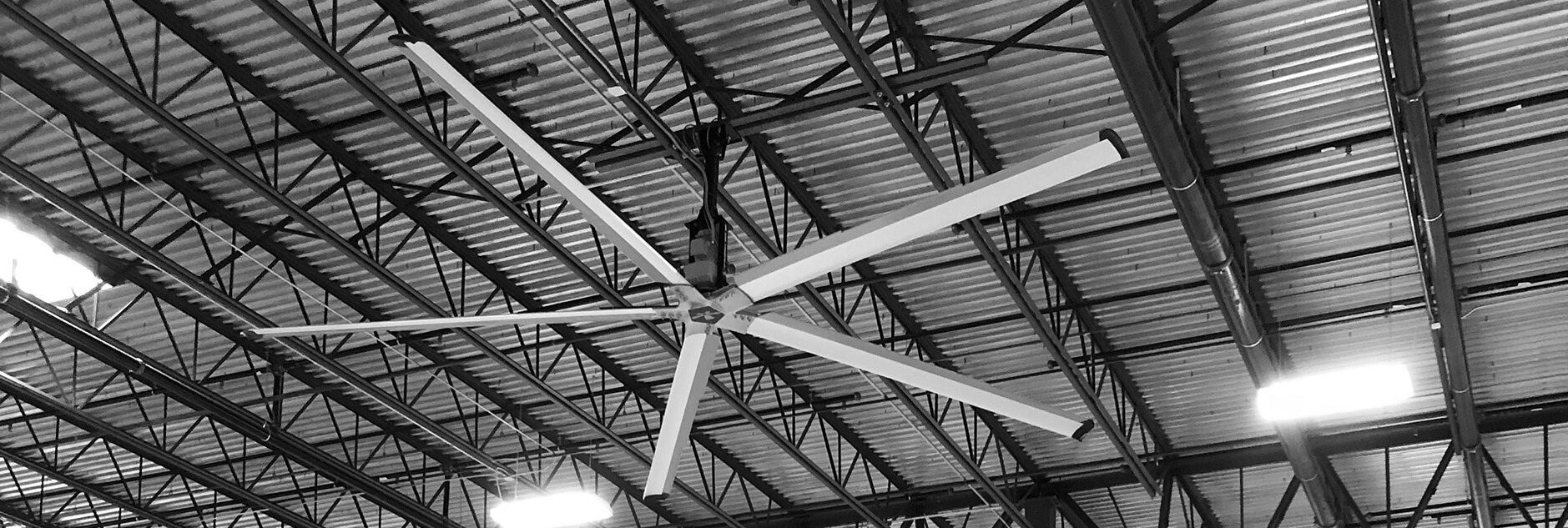The Differences Between HVLS Fans And Air Conditioning


If you’ve ever been shopping in the summer, you know how amazing it feels to walk from the hot sun into the cool oasis of a store. Either fans or air conditioning — or a combination of both — can be used to create this refreshing effect.
Are fans better than air conditioning? The short answer is that both are effective, but different. You should choose the one that is best for you depending on your goals and the space where it will be installed.
Ceiling Fan Vs. AC: How They Work
If you’re researching the advantages of a fan vs. an air conditioner, you’re probably also wondering “Is it cheaper to run a fan or AC?” First, let’s look at how the two systems work. HVLS fans and AC have several key differences in terms of function, cost and effectiveness.
Air Conditioning — Everyone knows that air conditioning is a method of cooling that literally transforms hot air into cold air and lowers the temperature in a building. Air conditioning works by lowering the air’s humidity. Air conditioners take air in, reduce its moisture and pump it back into the room.
Air conditioning is useful in environments where the air itself needs to be cool, for example at a day care full of little kids, an office building with many employees or a hospital with ill or recovering patients. However, air conditioning also is costly to operate, uses a large amount of electricity and cools unevenly, resulting in cold patches which can be uncomfortable.
HVLS Ceiling Fans — HVLS fans operate on a different principle. They focus less on transforming the air from hot to cool and more on creating a consistent airflow that leaves people feeling comfortably refreshed. HVLS ceiling fans don’t lower the air temperature. Instead, they utilize air diffusion and evaporative cooling to provide a comfortable atmosphere that makes people feel cool, keeps air fresh and lowers condensation.
The slow, steady movement of HVLS fan blades forces hot air to the ground and pulls cool air up. This creates constant, steady airflow that leads to evaporative cooling. Evaporative cooling is when moisture, such as perspiration, evaporates from the skin, leaving you feeling pleasantly refreshed and rejuvenated. The steady air current created by an HVLS ceiling fan also decreases water condensation on indoor surfaces during hot and humid weather.
HVLS fans are perfect for stuffy spaces that would benefit from consistent airflow. They also work well in enclosed buildings such as storage facilities, warehouses and factories that experience water condensation on merchandise and smooth surfaces.
Fan Vs. AC
Now that we’ve learned how ceiling fans and air conditioning work, let’s compare our options. Because fans don’t actually lower the temperature of a room, AC is probably your best option for extremely hot spaces or buildings filled with people. It lowers the temperature of a space by a significant amount and is guaranteed to keep you, your employees and your clients cool.
However, when you compare the fan vs. AC cost, fans are the clear winner. HVLS ceiling fans are not only cheaper to install than AC, but they are extremely energy efficient and can be used during the winter as well as the summer. HVLS fans run on very little electricity but have a major impact on even the largest of spaces. They also help keep buildings well ventilated and, as mentioned above, can be an excellent solution for condensation issues.
Find the Right Cooling Solution for You
Fortunately, we offer a wide variety of cooling appliances that will keep your building comfortable. From offices to factories to stadiums, we’ve got you covered. We even have products that combine AC and fans to give you the best of both worlds. Take our Z-Chill™ fan and diffuser system.
The Z-Chill™ is a combination ceiling fan and AC unit that offers an efficient, state-of-the-art solution for both summer heat and limited budgets. The air conditioner provides cold air that the fan circulates around the room, creating a cool space filled with fresh air. It also costs less to run than your typical air conditioning unit, thanks to the cutting-edge fan component.
Click here for more information on how our products can help you keep your cool even when you’re feeling the heat.
